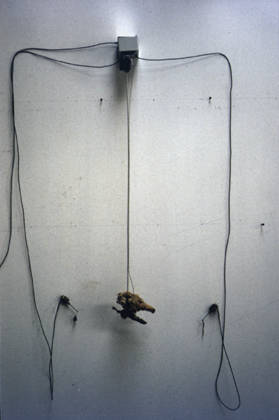







|
R e A n i m a t i o n s .
According to the utopia of the bio-technological era, technology should be an extension of our abilities. With the complete control of technology over nature, we, as lord and master, should be able to mould and form all life in our own image. However, the other side of this ecstatic vision shows us to be extensions of all the machines and all the media into which we plug ourselves day in and day out: it is not we who make use of technology - technology makes use of us. The wildness of nature has ironically made place for the wildness of technology, which produces unexpected, unprecedented and unpredictable fusions of body and machine.
How else could those dark, unstable, compounds of body and machine in Re-Animations have seen the light? Re-Animations is a multi-component installation in which remnants of birds and other animals have been brought back to life by means of microprocessors. Or is it the other way around? It seems as if the balance of the combination of emphatically visible technology and biological elements, such as skulls, bones and feathers, could tip both ways.

Re-Animations is an interactive Wunderkammer in which, at each new showing, the curiosities present themselves in new configurations. The moment you enter the room, it is filled with shrieking, clapping or ticking noises, generated by the machinery of the various objects, as if you were in a futuristic zoo. These are hybrid, half-technological, half-animal figures, made of wire, metal rods or cable, which suddenly come to 'life', responding to your presence and to each other.

Metal rods reach out from two of the walls with, on each of the extremities, the skulls of storks which rattle and move almost aggressively against each other, or against the visitor. They are a warning against coming too close. There is a half-decayed dog's head ("Dogged"), connected on either side, via wires, to small mechanisms whose loose-hanging components bang against each other. There is a deer's head whose ears move. On the floor stands a box in which rust particles and electromagnets swarm with 'life'...
In a way which is both clever and penetrant, Zwanikken plays the natural off against the artificial, and against the viewer as well, who loses his authoritative and autonomous role: he finds himself in a room governed by a different order and hierarchy, where he is also 'on display' himself. Because, due to the unpredictability and uncontrollability of the computer-aided movements and sounds in the animated exhibition model of Re-Animations, it is not certain who responds to whom, and who or what is looking or being looked at. Zwanikken ironizes the hype of the interactive in media art, and the illusion of smooth-running communications, in installations in which technology always seems to be 'out of control', and the choreography of the objects governs the choreography of the viewer as well as the other way around.
Jorinde Seijdel
|